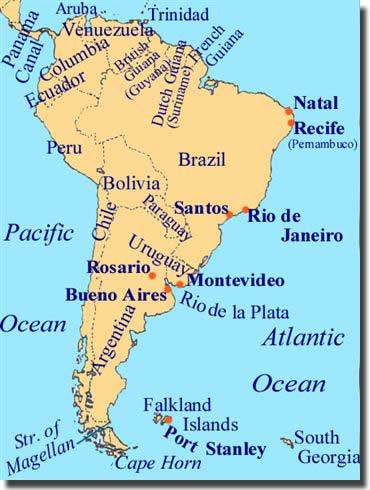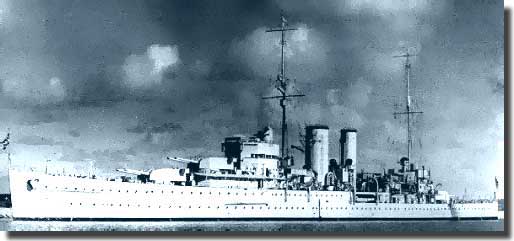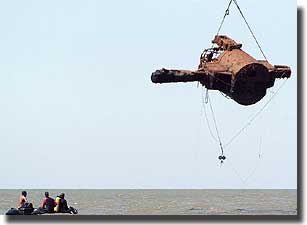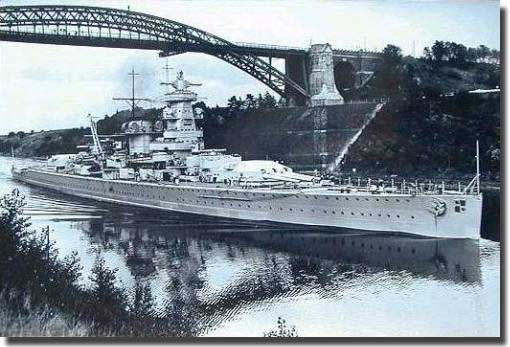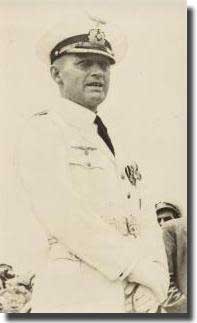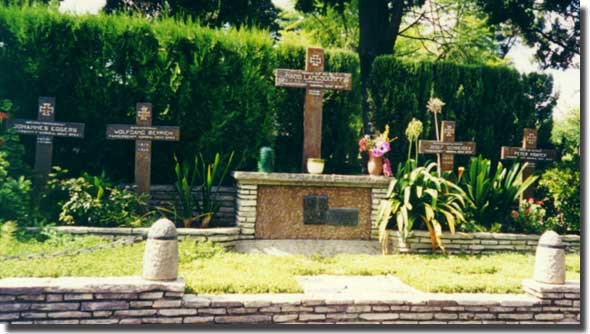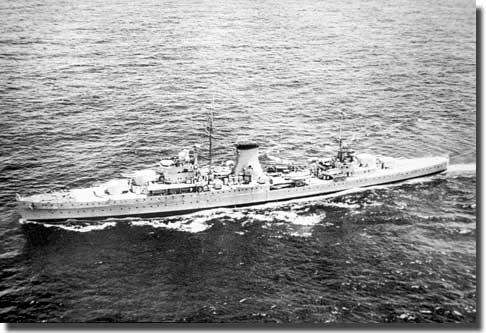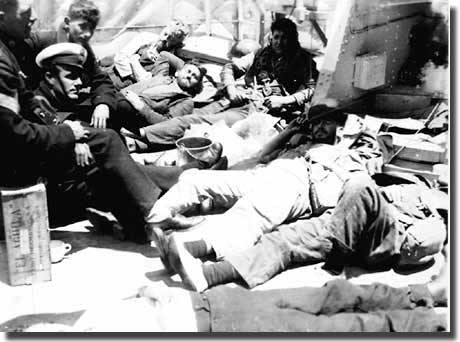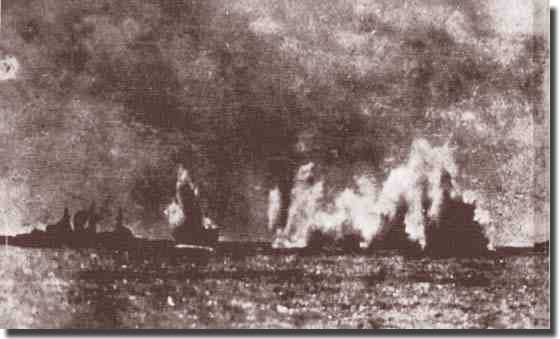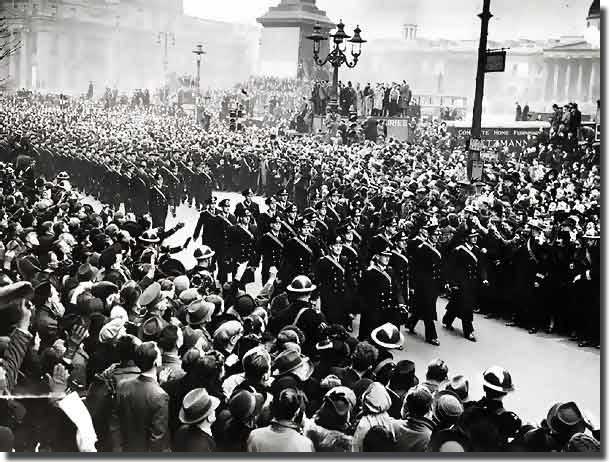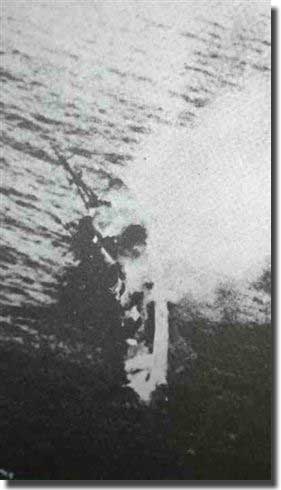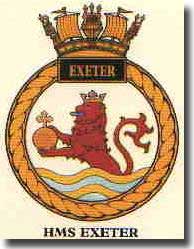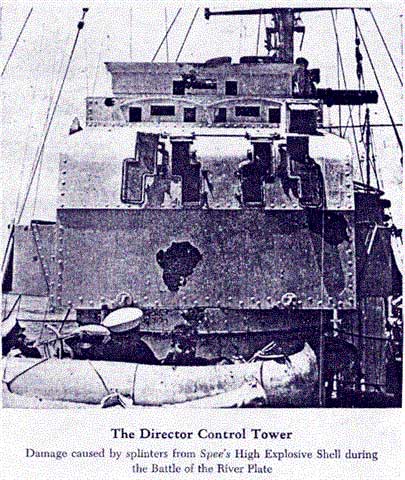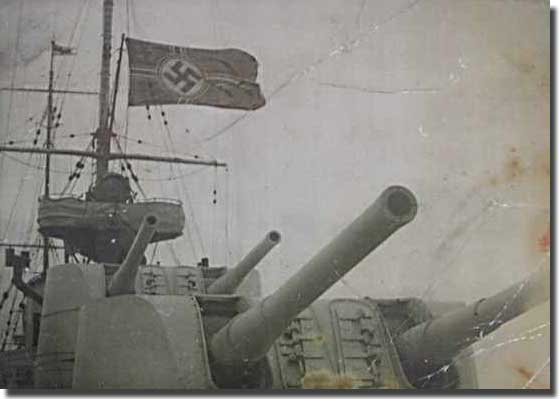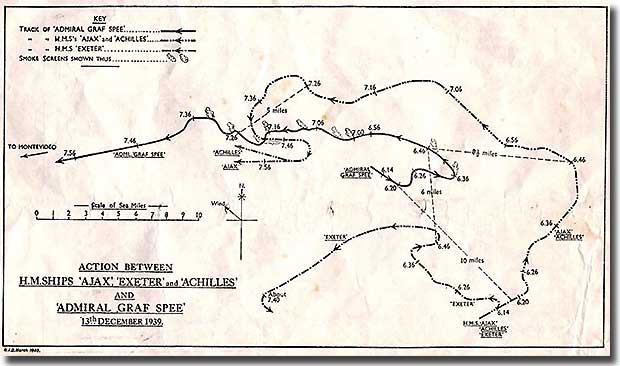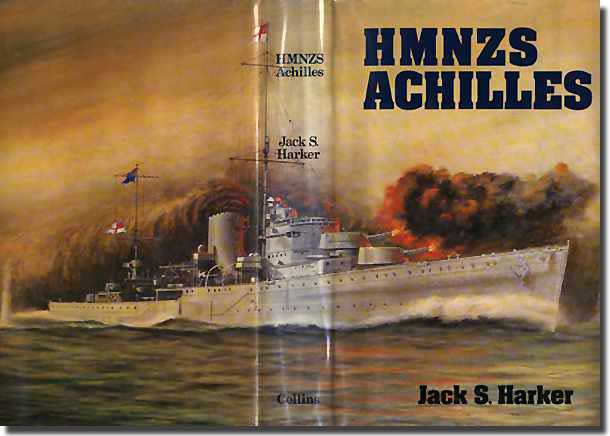|
The Battle of the River Plate. 13th. December 1939.
(See the pictures at the bottom of the page.) Introduction. In the main, I have relied on Rear Admiral Henry Harwood's despatch to the Admiralty, he reports the action that took place on the 13th. of December 1939, between the Graf Spee, and his ships from the South American Division, Exeter, Ajax, and Achilles, plus the events leading up to that operation. At this action he was a Commodore, then it was temporary rank between that of a Captain and a Rear Admiral, only much later did Commodore become a substantive rank in the Navy. For the victory achieved by Harwood's forces, he was promoted to Rear Admiral. Early in WW2. Commodore Henry Harwood's South American Division. The Commodore on learning about these two reports made several assumptions:
But Commodore Harwood went for the most likely point, and chose the River Plate where he believed the pocket battleship would decide to steam, this point would hold the best chance of success as the greatest concentation of shipping would pass through that area. Then on the 3rd. of December, he ordered HMS Achilles ( a New Zealand manned ship ) commanded by Captain W. E. Parry RN, to leave the Rio area, and arrive and fuel off Montevideo by 0600 ( 6 AM ) on the 8th. of December. HMS Exeter under the command of Captain F. S. Bell RN, was to leave the Falklands for the River Plate, to arrive AM on the 9th. of December. HMS Ajax under the command of Captain C. H. C. Wood RN and Achilles were then to concentrate in position 35 degrees South, 50 degrees West at 1600 ( 4 PM ) on the 10th. of December. Exeter to join up with the two other cruisers by 0700 ( 7 AM ) on the 12th. The oiler Olynthus was ordered to stay at the sea rendezvous. Thus by 0700 ( 7AM ) on the 12th. of December all three cruisers as ordered were all together, and they steamed to the most congested shipping spot at 32 degrees South 47 degrees West, it was here that any Raider might achieve the greatest damage to British shipping passing through this focal position. Harwood now signalled his intentions to all three cruisers: By day, they would operate as two units, the 1st. Division, Ajax, with Achilles , and Exeter would be diverged. Forcing the Raider to split her armament, if she wished to engage both groups at the same time. By night the 3 cruisers were to operate in company but in open order. 13th. of December 1939.
It did not take long for Graf Spee to act, in only two minutes she opened fire with her 11 inch turrets, one firing at Exeter, and one at Ajax. The first division altered course to 340 degrees to close the range to the enemy, whilst Captain Bell hauled out of the line, altering course to the west, so he might attack Graf Spee from a widely different angle. All ships increased speed, now it should be noted that the enemy armament had almost twice the power of the British By 0623 ( 6.23 AM ) all ships had opened fire, and an enemy report was broadcast. The enemy ship seemed undecided about her gunnery policy, as she shifted targets several times before concentrating both turrets upon Exeter. The third salvo from Graf Spee straddled Exeter ( that means shells in a salvo fall both sides of the target ), one shell burst short, and killed the starboard torpedo tube crews, riddled the searchlights and the aircraft on the catapult, which was manhandled over the side, leaving the ship without any spotting capability from that source. By 0624 ( 6.24 AM ) Exeter sent off 8 salvoes against the enemy, but on the incoming path, she received a direct hit from an 11 shell in the fore part of the B turret, putting it out of action, as splinters from this shell burst swept the bridge it killed or wounded all personnel there except for the Captain and two others. It also demolished the wheel house communications, leaving Captain Bell without any means of giving wheel orders to enable course changes, or orders to the engine room regarding speed changes. He decided to fight his ship from the after conning position, but the communication system here was also damaged from the shell burst earlier that effected the torpedo tube crews etc. A chain of messengers was set up to pass orders to the after steering position. Now two further 11 inch shell hits registerd in the fore part of the cruiser, and Graf Spee shifted one 11 inch turret onto Ajax, who was straddled three times. The secondary armament of the German ship now took on Ajax and Achilles alternately, but to little effect. During all of this intensive engagement, Ajax achieved a minor miracle by being able to catapult her aircraft for spotting purposes. Exeter had fired off her torpedoes at 0632 ( 6.32 AM, ) but did not achieve any result, now at 0637 ( 6.37 AM ) Graf Spee altered course some 150 degrees, steering to the North West under cover of smoke. 0638 to 0650 ( 6.38 to 6.50 AM ) Two more 11 inch hits fell upon Exeter, one put A turret out of action, and another started a fierce fire in the Chief Petty Officer's flat amidships, the 4 inch magazine was flooded through a burst water main. All the compass repeaters were out of action, the Captain had to rely on a simple boat's compass to allow him to keep the ship pointed so that Y turret might keep up her firing at the enemy, locally controlled, with the Gunnery Officer taking control from the searchlight platform. At 0640 ( 6.40. AM ) an 11 inch shell fell just short of Achilles in line with her bridge, it burst at the waterline, with splinters killing four sailors, stunning the Gunnery Officer, ( many unkind Officers might comment, But that is but the normal condition for most Gunnery Officers. ) and slightly wounding the Captain and his Chief Yeoman of Signals. 0650 to 0708. ( 6.50 to 7.08 AM ) Graf Spee made frequent course alterations trying to throw off the British ship's gunfire, she also made skilful use of the smoke she generated. Exeter valiently kept up firing her Y turret in local control, but she now had developed a 7 degree list to starboard, adding to the difficulties of keeping Y turret firing. She was still a target for fire from Graf Spee, but shots fell consistantly over. 0708 to 0728. ( 7.08 to 7.28 AM ) At 0708 ( 7. 08 AM ) Graf Spee made a dramatic alteration of course to port under cover of her smoke, and at 0720 ( 7. 20 AM ) she turned back to the North West to bring her guns to bear, and Ajax was very quickly straddled three times from a range of 11,000 yards. At the same time, the First Division turned to starboard to bring all their main armament bearing on Graf Spee, their fire appeared to most effective with Graf Spee on fire amidships. But at 0725 ( 7. 25 AM ) Ajax was hit by an 11 inch delayed action shell on the after superstructure, its passed through some cabins, wrecking them, then it went through X turret trunk, wrecking all the turret machinery below the gun house, a part of this shell base then struck Y turret barbette, close to the turret training rack, and jammed the turret. Thus one shell was responsible for putting both X and Y turrets out of action, for killing four, and wounding another six of X turret's crew. It appeared that Graf Spee was neglecting Exeter, as she steered North West to close on the First Division, with Ajax assuming that the German ship would hold this course, she decided to fire off a broadside of her torpedoes. At 0724 ( 7. 24 A M ) she turned to starboard, and let go four torpedoes at a range of 9,000 yards, but without result. Graf Spee must have seen them coming, and quickly took avoiding action by turning 130 degrees to port, and then returned to the North West after about three minutes. Exeter was slowly dropping astern of the action, the forward damage taking it's toll. At 0740 ( 7. 40 A M ) Y turret still in local control stopped firing, this was due to a power failure caused by flooding. At 0740 ( 7. 40 A M ) Exeter was steering South East at a very slow speed, she needed to both make repairs and herself seaworthy again. Now Ajax and Achilles altered course to 260 degrees so that the range to the enemy was reduced even more, then at 0721 ( 7.21 A M ) the spotting aircraft reported "Torpedoes approaching, they will pass ahead of you." The two cruisers decided to make sure they missed, and altered course to 180 degrees. At 0732 ( 7.32 AM ) Graf Spee turned away to the West and started to zig zag, and Ajax seemed to be making good use of her three available guns, one of the hoists had failed in B turret, and both X and Y turrets were out of action. Suddenly at 0736, ( 7.36 AM ) Graf Spee altered course to the South West to again bring all her armament to bear on the First Division, the range now down to 8,000 yards. Ajax reported she had only 20% of her ammunition left. The shooting by Graf Spee was accurate, and Commodore Harwood did not think she had suffered much damage from the salvoes from the British ships, so he decided to break off the action, at least till after dark. One of the last salvoes from the enemy had demolished Ajax's top mast, and with it all of her aerials, so jury aerials were rigged as quickly as possible. As the British ships turned away, Graf Spee did not follow them, but then altered course to 270 degrees, her speed 22 knots, this course would take her directly to the River Plate. The First Division, now turned to place themselves in shadowing positions on both quarters of the German ship, at a distance of about 15 miles. British shipping in the area was alerted to Graf Spee's position, course and speed, this information was also sent off to the British Admiralty. At 0912 ( 9.12 AM ) Ajax recovered her aircraft, then at 0916 ( 9.16 AM ) Harwood ordered Cumberland from the Falkland Islands to close the River Plate at full speed, he was in dire need of reinforcements to his force. At 1104 ( 11.04 AM ) a merchant ship close to Graf Spee was stopped and blowing off clouds of steam, a signal from the pocket battleship read: "Please pick up lifeboats of English steamer." When coming up to the British ship, SS Shakespeare, all her boats were hoisted, and she reported that she was not in need of any assistance. At 1105 ( 11.05 AM ) Exeter signalled that all her turrets were out of action, she was flooded up to No. 14 bulkhead, but could proceed at 18 knots, she was ordered to sail to the Falkland Islands at her best speed without placing strain on her bulkheads. At 1342 ( 1.42 PM ) the British Naval Attache at Buenos Airies was informed that Graf Spee was making for the Plate. The shadowing of Graf Spee continued, and at 1915 ( 7.15 PM ) she suddenly fired off two salvoes at Ajax who turned away under smoke, the first salvo fell in line, the second in her wake as she turned, the range 26,000 yards. It now seemed that Graf Spee intended to enter the Plate, and Achilles was told to follow her if she went West of Lobos, now Ajax was to proceed South of the English Bank, just in case the German doubled back that way. Just after sunset, Graf Spee fired off three salvoes at Achilles, the third lobbed very close, in return, Achilles fired 5 salvoes that seemed to straddle the enemy ship. Graf Spee now proceeded North of the English Bank, and anchored in Montevideo roads at 0050. ( 00.50 AM ) Harwood now reports that his main concern was how long Graf Spee intended to stay here. At 2350 ( 11.50 PM ) Ajax and Achilles were ordered to withdraw from the Plate, Harwood did not want to risk them having to face Graf Spee silhouetted by the rising sun behind them. Achilles was to patrol the area from the Urugayan coast to a line 120 degrees from English Bank, whilst Ajax was to look after the Southern area. Both cruisers were to move back to the mouth of the Plate after the threat posed by the dawn had passed. Thurday the 14th. of December. The heavy cruiser Cumberland signalled that she would arrive at 2200 ( 10 PM ) on the 14th. of December, and she was told to cover the sector between Rouen and English Banks, with Achilles to the North of her, and Ajax to the South. Should the German ship exit the River Plate, she was to be shadowed, and all three cruisers were to concentrate to seaward, so that a concerted attack might be made. Friday the 15th. of December. The Commodore must have been a worried man at this stage, he wanted to ensure the utter destruction of Graf Spee, two of his available ships had sustained damage in the earlier encounter, supporting ships although on their way, were still days off arrival. He was kept busy trying to cover all possible scenarios, be prepared by refueling his ships, and keeping the enemy ship cooped up at Montevideo. At this stage he did not know what damage had been inflicted on the German in the running battle that had ensued earlier, he tended to believe that she was largely undamaged, and still posing an enormous threat to his available forces. Harwood now sent the following policy signal at 1135 ( 11.35 AM ) on the 15th. of December:
Ajax took in 200 tons of fuel from Olynthus, but bad weather caused wires to part including two hurricane hawsers, now Ajax sailed to join up with Cumberland. The Commodore received a report that Graf Spee landed a funeral party, and that she had been granted an extension of her stay up to 72 hours, to allow repairs to make her seaworthy. It seemed that the German ship had sustained damage to a greater degree than at first thought, 36 sailors had died and another 60 were wounded. The British ship Ashworth was sailed at 1900 ( 7 PM ) and Graf Spee accepted the edict that she could not sail for another 24 hours from that time. Commodore Harwood stated that he could not feel secure that she would not try to break out at any moment. Saturday the 16th. of December. The aircraft was fired upon when close to Whistle Buoy, which may have meant that the Graf Spee was trying to break out, and all ships went to action stations, soon to be stood down, as a report stated the German ship was still anchored in harbour. The British Minister at Montevideo was advised of this shooting, and asked to use an investigation of the incident to further delay sailing of the Graf Spee. His reply indicated Graf Spee was not the culprit, it was probably the Argentine Gun Boat stationed at Recalda. The Admiralty advised the British Naval force it was free to engage Graf Spee outside the 3 mile limit, and this force moved to an area north and east of English Bank, to allow more sea room for any ensuing battle, and also to preclude the possibility of any over shells landing in Uruguay. It was further reported that Graf Spee was still under repair, receiving assistance in this regard from the shore, she had also been provisioned. It seemed unlikely she would sail tonight, but Commodore Harwood felt he could not relax and just rely on this information, both he and his ships must remain ever vigilent, the cat and mouse game went on! At 1615 ( 4.15 PM ) he signalled his ships in company:
The British ship Demster Grange was sailed out of Montevideo at 1700 ( 5 PM ) and a further period before Graf Spee could be allowed to sail was claimed. It was reported that repairs to her were almost completed, and she might try to break out at any moment. A signal from the Admiralty stated Commodore Henry Harwood was promoted Rear Admiral from the 13th. of December, and the King bestowed the Knight Companion of the Bath ( KCB ) on him, and the Companion of the Bath ( CB ) on the three cruiser Captains, C.H.L Woodhouse in Ajax, W.E. Parry in Achilles, and F. S. Bell in Exeter. Much rejoicing in the British ships lying in wait off the River Plate. The night was spent patrolling on a north/south line 5 miles east of the English Bank Light Buoy. Olynthus was sent to be off Rouen Bank by 1000 ( 10 AM ) on the 17th. if Graf Spee had not appeared. Sunday the 17th. of December. At 1540 ( 3.40 P M ) a signal came in that Graf Spee had transferred 300/400 men to the German ship Tacoma, and at 1720 ( 5.20 PM ) another report stated 700 men with their baggage had been transferred, and that there were indications that it was intended to scuttle Graf Spee. Now she is weighing anchor. Will she come out and fight? and was landing many crew just to save lives, or will she be scuttled? The British force closed the Whistle Buoy at 25 knots, and Ajax's aircraft was flown off towards Montevideo to report on both Graf Spee and Tacoma. At 1815 ( 6.15 PM ) Graf Spee sailed and slowly proceeded to the west, with Tacoma following her out of harbour. The Royal Navy Squadron went to action stations in case Graf Spee either recovered crew members from Tacoma, or tried to break out with her reduced crew. The aircraft from Ajax sighted Graf Spee in shallow water some 6 miles south west of Montevideo, and at 2054 ( 8.54 PM ) signalled the great news: "Graf Spee has blown herself up." The Squadron proceeded towards Montevideo, passing north of the English Bank, with Ajax and Achilles cheering ship as they passed one another. It was almost dark when the aircraft from Ajax was recovered, now navigation lights were switched on, as the Squadron steamed past the Whistle Buoy, only 4 miles from the wreck of Graf Spee. She was now ablaze from end to end, with the flames leaping as high as the top of the control tower. " A magnificent and cheering sight!" So, a proud and mighty ship came to a self destructive end, and the Battle of the River Plate was, at last over.
South America
HMS Exeter
Communications tower from Graf Spee raised after 64 years sitting under the ocean
Graf Spee in the Kiel Canal pre WW2.
http://www.bobhenneman.info/grafspeepics.htm A batch of Graf Spee pictures
Graf Spee's Captain H.W. Langdorff
Captain Langdorff's grave in Buenos Airies
HMS Ajax
Men resting on deck of Achilles after the Battle of the River Plate
A Japanese photograph. Exeter straddled by fire from Japanese cruisers Nachi and Haguro
Crews from Exeter and Ajax, march through London in February of 1940, to receive a heroes welcome home.
The last throes of Exeter
Crest of HMS Exeter
A captured German Ensign from Graf Spee flies on board Achilles.
Track Chart of the Battle of the River Plate.
|

